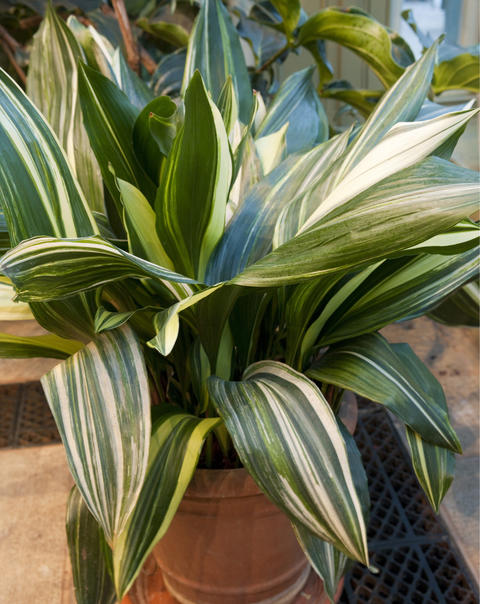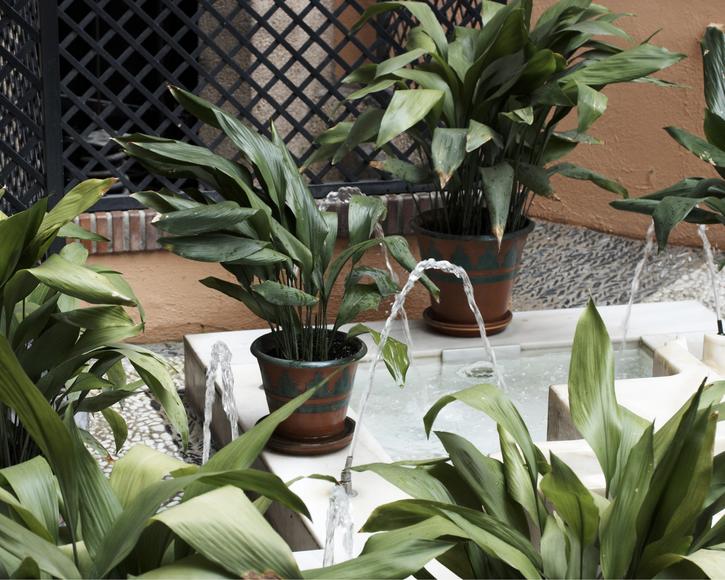Cast iron plant, Bar room plant
The Cast iron plant is considered undemanding and indestructible. You can find a portrait for the popular houseplant with numerous care tips, here.
Factsheet
- Growth type
-
- Perennial plant
- rhizome
- Growth height (from)
- from 60 cm to 80 cm
- Growth width (from)
- from 40 cm to 60 cm
- Growth characteristics
-
- horst-forming
- Flower color
-
- white
- brown
- Flower shape
-
- Uniflorous
- Bells
- Flower characteristics
-
- unimpressive
- Leaf color
-
- green
- page format
-
- broad
- stalked
- long pointed
- pointed
- Sheet properties
-
- evergreen
- Light
-
- scattered light to semi-shade
- Soil type
-
- sandy
- Soil Moisture
-
- fresh to humid
- Nutrient requirements
-
- low in nutrients
- Decorative or utility value
-
- Leaf ornaments
- Winter Hardness
-
- conditionally hardy
- Use
-
- Interior greening
- Planters
- Winter garden
- Garden style
-
- Pot garden
The houseplant known as the Cast iron or bar room plant is the species Aspidistra elatior from the Aspidistra genus. This plant genus has over 90 species and belong to the Asparagaceae family. It originates from the forests of China and Japan. The Cast iron plant quickly established itself across all of Europe as a ‘ubiquitous’ houseplant thanks to its robustness and uncomplicated care requirements, and enjoys a reputation as an indestructible houseplant. The leafy plant is often used as decoration in offices, restaurants and stores in particular (which is why it is often sometimes known as the bar room plant). Its long leaves are also used by florists as foliage ornamentation.
The cast iron plant is a slow growing evergreen, herby plant which grows to about 32 inches tall. Unlike classic palms, the cast iron plant does not have a trunk. Its long, lanceolate, stalked leaves grow directly from the extremely woody, creeping rhizome, which gives it its compact and voluminous appearance.
The Cast iron plant’s leaves consist of an approximately 6 inch long stalk with large lamina which elegantly overhang. They taper to points, are dark green and shiny. Some varieties also have white or yellow dotted or striped foliage.

The Cast iron plant flowers directly above the soil surface, as its flower stalks are extremely short. The bell-shaped, fleshy, single flowers are creme or reddish-brown colored and appear close to the soil, directly between the petioles. Its pollinators are therefore not insects, but soil organisms. The cast iron plant rarely flowers as a pot plant. The well hidden flowers can often hardly be seen at all.
The pot plant should be placed in a light location but out of direct sunlight. A north-facing window is the best spot for an Aspidistra. However, the cast iron plant also manages with a much lower light yield. If you are looking for a green plant for a really dark corner of the house, you can use a cast iron plant. However, it will grow much more slowly and with a stouter appearance in such locations. Exception: The white-green variety Aspidistra elatior ‘Variegata’ requires a very bright spot as otherwise it loses its markings. As the cast iron plant is not winter-hardy and cannot tolerate temperatures below 50 degrees Fahrenheit, it can only remain outside during the summer in a sheltered, off-sunny location. As a houseplant it can be cultivated all year round at the same temperature. The Cast iron plant can be planted in standard commercial container soil, if necessary with some sand admixture. A layer of expanded clay ensures good drainage.

Large, dark green leaves such as those of the Cast iron plant evaporate lots of water from their surfaces. Therefore, it should be thoroughly watered at regular but not too frequent intervals, without leading to waterlogging. The substrate should be well dried out on the surface between watering. The watering requirements drop during the winter. However, even though it loves regular watering and high humidity, the Cast iron plant can also stoically cope with temporary neglect. This makes the Aspidistra a perfect plant for beginners. Its lack of sensitivity to light and temperature fluctuations, draft and low humidity makes the pot plant predestined for passage rooms and people without much gardening experience.
For healthy growth, the Cast bar room plant should be given some liquid fertilizer for green plants or palms with its water about once a month, or some long-lasting fertilizer once at the start of the growth period in the spring (granulate or fertilizer stick). Note: The Cast iron plant has low nutrient requirements. If it is over-fertilized, the leaves tear lengthwise.

The Cast iron plant can be re-potted every three to four years in the spring. You can recognize when it is time to re-pot as the pot ball will be heavily rooted or the rhizomes will already visible around the top edge. Plant the cast iron plant exactly as deep in the new pot as it stood in the old one. Tip: If the Cast iron plant has become dusty, simply water it in the shower and wipe off the leaves.
Today Cast iron plants are no longer so readily commercially available, because they have been considered old-fashioned for some time and there is very low demand. This means the varieties are also hard to come by, even if they are a sight to behold: ‘Milky Way’ has white dotted leaves while ‘Ginga Giant’ leaves have yellow dots. ‘Snow Cap’ has dark green leaves with whitewashed leaf tips. ‘Lennon’s Song’ has a white line running lengthwise along the center of the leaf.

The most successful and easiest way to propagate the Cast iron plant is by dividing the root in the spring. For this, divide the rootstock into smaller parts by hand or with a sharp knife. The individual rhizome pieces can be easily broken away. Each section of the stock should have at least two leaves. Then push the entire rhizome cutting into potting soil and water. Tip: Plant several young plants together in a pot to create a dense, new plant. The rhizome should be potted shallow, so that it is only just beneath surface soil layer. Initially, young plants should be placed in semi-shade until they have fully taken root.
Cast iron plants occasionally fall foul to spider mites and thunderbugs. When an infestation takes hold, the entire plant can be thoroughly rinsed under the shower. You can treat the plant further with a pest agent. Dry patches on leaves in a sunny location indicate sunburn. If the leaves are yellow and soft, the Cast iron plant is probably standing in too much water. Remove excess water and allow the substrate to dry out well between watering. If a breed of the Cast iron plant doesn’t have the expected foliage pattern, it is either still too young (some foliage patterns only appear on older plants) or it is in too much shade.

